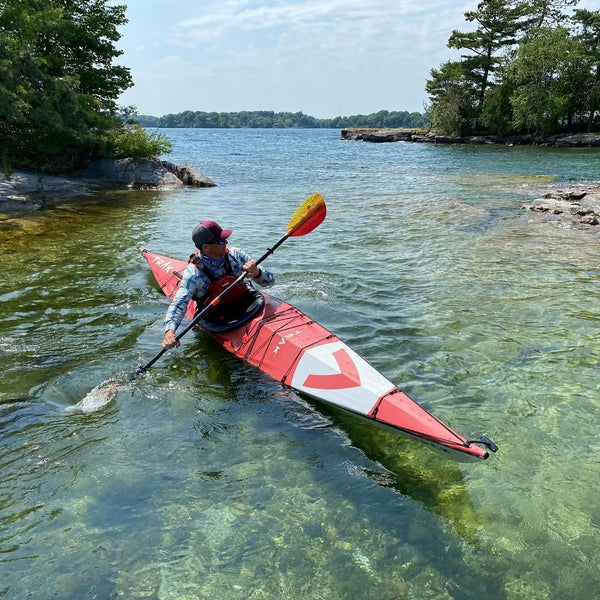We met Maeghan at the Green Street parking area, a familiar place to all of us. Located on the mouth of the Saranac River, it’s the take out for the whitewater run that passes through campus and also a convenient launch point to start touring on Lake Champlain. Maeghan had graduated from the same Expeditionary Studies program as us a few years back, was now working in the paddlesports industry, and had come back to campus to give a TRAK demo as a TRAK Pilot. It was early May and the semester was just wrapping up with finals a week away. Garrett and I were excited to see the boat live and in person. We had recently watched the older “TRAK Files” videos and the clip with Jamie Sharpe surfing a TRAK on Skookumchuck. The TRAK seemed like the perfect boat to a couple of Expeditionary Studies majors, though we had never actually seen one in person.
One of the most difficult things about being twenty-something year old college students is figuring out how to take a boat with you. A constant theme of “self-sufficiency” was present throughout our education, and while this is rarely achieved in an ultimate sense, it is an ideal to strive for and it does inform how we plan our trips. These boats seemed to be what we were looking for, and certainly lent themselves to a self-sufficient expedition.
In order to graduate with a bachelor’s degree, we each had to complete the “Senior Expedition”- a final course that requires the student to plan, propose, execute, and give a presentation on an expedition created from scratch. Garrett’s vision was to sea kayak part of the Pacific coast of Baja, expedition style, while bringing surfboards strapped on the back decks. I raised an eyebrow at this idea, and he confidently assured me that he had strapped his shortboard to the stern deck of one of the school’s kayak and could still roll just fine- as if the ability to roll a kayak with a surfboard was the only safety variable. At the time, and admittedly with a bit of naivety, that was enough for me to come fully on board. The plan became clear and a vision of taking the expeditionary nature of the sea kayak - its ability to sustain a paddler self-supported for multi-day trips, combining it with the classic surf road trip – came to life. Our aim was to explore a small section of coast with incredibly interesting water features, surf as much as we could both in kayaks and on boards, all while camping out and sustaining ourselves with what we had.
Garrett touched up his “Expedition Proposal”; the written assignment required for his Senior Expedition Planning course that outlined the objectives and risk management plan, among other things, and used it to propose the trip to TRAK Kayaks. After a few months of back and forth emails, a few Skype calls, and logistical planning, we’d become sponsored to use TRAK kayaks on this expedition. Garrett and I, along with our new team member and best friend, James, were beyond stoked and surprised by this.
We received critical intel and support from my future (now current) employer, Ginni Callahan, British Canoeing coach and owner of Sea Kayak Baja Mexico located in Loreto, B.C.S. She offered local knowledge and route information that ultimately informed the actual section of coast we paddled, plus she arranged with a local contact for shuttling, resupply, and general support on either end of the trip. Without these critical logistical favors, many more things would have been left up to chance- we cannot stress enough the importance in having secured these details from her and we remain very thankful.
The trip surpassed all of our expectations, and I feel that the expedition was a comprehensive learning experience that laid a massive foundation for us to work on future projects with the TRAK kayak. Personally, I’m extremely excited by the boat’s performance and I believe this first trip is the beginning of a series of trips focused on that same “coastal play” theme, with many new locations and features waiting to be explored. I also feel a great push of momentum coming off the trip, coming out of it officially as a TRAK Pilot, and also getting to help put another TRAK training expedition on the water in the Gulf of California this past week. I was able to check out the TRAK 2.0 and the new model really is extremely exciting. With the replacement of the plastic ribs with carbon fiber, the boat is much more rigid, resulting in huge performance increases. Just pushing against the skin or the ribs with the boat put together, it felt like an entirely different boat. The increased rigidity in the frame will absolutely result in more efficient power transfer as well as frame durability- both key elements in dynamic environments. That said, I’m obviously stoked for TRAK 2.0’s release, being a TRAK Pilot, and finishing a strong season in Baja followed by my upcoming summer working in the Pacific Northwest - bringing my TRAK along, of course.
Read Ted's article in Ocean Paddler Magazine - Download Issue #62 Right Here
Ready to dive in?







Share: